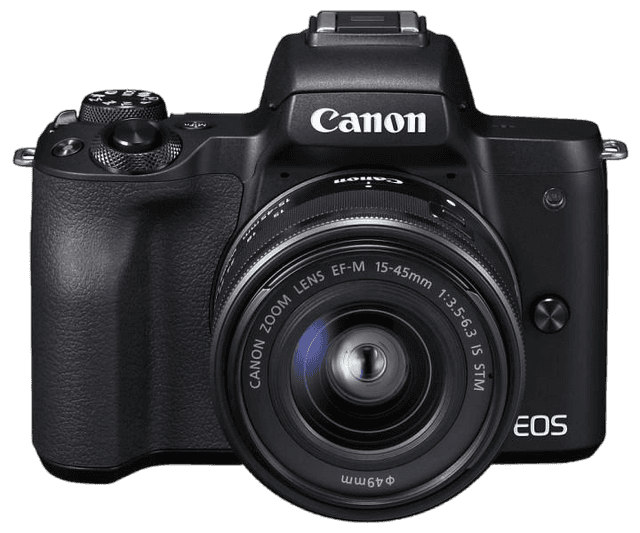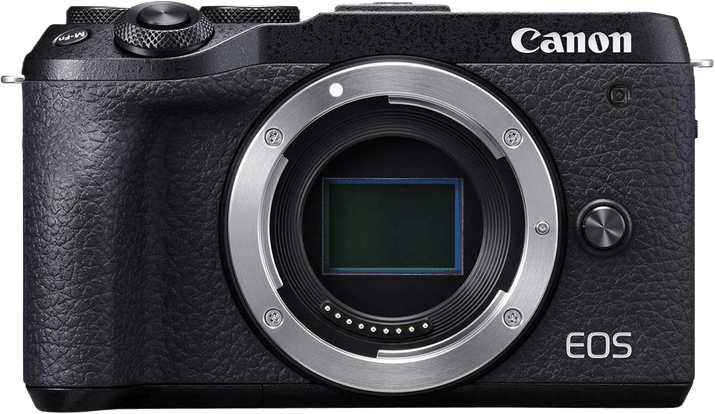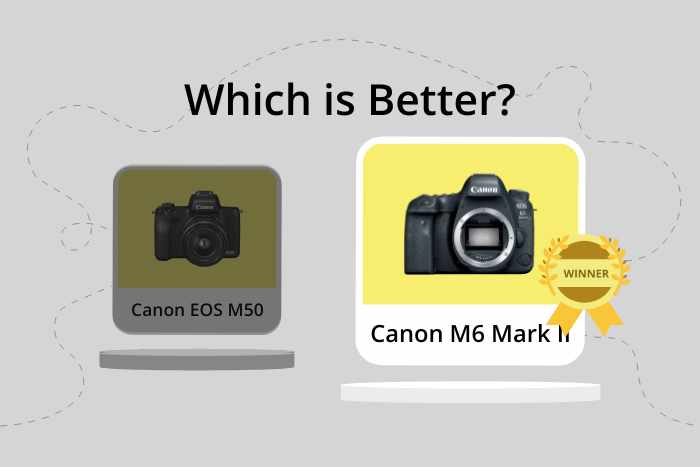Canon EOS M50 vs EOS M6 Mark II Comparison
Canon EOS M50

Canon EOS M6 Mark II

The Canon EOS M6 Mark II emerges as the winner, scoring 63/100, compared to the Canon EOS M50‘s score of 59/100. Both cameras are mirrorless and share similar specifications, such as their announcement dates in 2018 and 2019, and their launch prices of $779 and $850, respectively.
The EOS M6 Mark II outperforms the EOS M50 with its smaller size, measuring 120 x 70 x 49mm, making it more compact for travel and daily use. However, the M50 has a slight advantage in terms of weight, being lighter at 390g compared to the M6 Mark II’s 408g.
Considering these factors, the Canon EOS M6 Mark II proves to be a better camera with its higher score and compact size, while the EOS M50 offers a lighter option for those prioritizing weight.
Canon EOS M50 vs EOS M6 Mark II Overview and Optics
The Canon EOS M6 Mark II wins in the optics comparison with a score of 62/100, while the Canon EOS M50 scores slightly lower at 59/100. Both cameras share several specifications, including a CMOS sensor, Digic 8 processor, DXOMARK sensor score of 58, APS-C sensor size, Canon EF-M lens mount, and lack of image stabilization.
The EOS M6 Mark II edges out the M50 in terms of megapixels and shooting speed. With 33 megapixels, the M6 Mark II captures more detail in images compared to the M50’s 24 megapixels. Additionally, the M6 Mark II boasts a faster shooting speed of 14 frames per second, allowing for better action and sports photography than the M50’s 10 frames per second.
Despite these advantages, the EOS M50 still holds its ground in certain aspects. For instance, both cameras have the same sensor type, processor, and sensor size, meaning they perform similarly in terms of image quality and low-light performance.
In conclusion, the Canon EOS M6 Mark II’s higher megapixel count and faster shooting speed make it a better choice for those looking to capture more detail and faster action. However, the Canon EOS M50 still offers solid performance and shares many specifications with the M6 Mark II. Ultimately, the decision between these two cameras will depend on the specific needs and preferences of the photographer.
Canon EOS M50 vs EOS M6 Mark II Video Performance
When comparing the Canon EOS M50 and Canon EOS M6 Mark II’s video capabilities, both cameras earn a score of 91/100. This result shows that they have similar performance and quality in terms of video recording.
Both cameras share the same maximum video resolution of 4K, with dimensions of 3840 x 2160. This high resolution ensures that users can capture sharp and detailed video footage. Additionally, both the EOS M50 and EOS M6 Mark II have a maximum video frame rate of 120fps, allowing for smooth slow-motion video capture. Both cameras also have built-in time-lapse functionality, providing photographers with creative options for capturing dynamic scenes.
The Canon EOS M50 and EOS M6 Mark II share many common video features, making it difficult to determine a clear winner between the two. However, there may be specific factors that make one camera more suitable for certain users. For instance, the EOS M50 might appeal more to beginners due to its user-friendly interface, while the EOS M6 Mark II might be more suitable for advanced users seeking additional features and customization options.
In comparing the video capabilities of the Canon EOS M50 and EOS M6 Mark II, it is evident that both cameras perform well and offer similar features. As such, the choice between the two will depend on the user’s preferences and specific needs. Ultimately, either camera will provide high-quality video recording and creative functionality for photographers and videographers alike.
Canon EOS M50 vs EOS M6 Mark II Features and Benefits
The Canon EOS M50 and the Canon EOS M6 Mark II both score 70/100 in terms of features, making them equal in this regard. They share several specifications, such as a 3-inch screen size, 1040000-dot screen resolution, touchscreen capability, flip screen, absence of GPS, and inclusion of WIFI and Bluetooth connectivity.
Despite having the same feature score, the Canon EOS M50 excels in certain aspects. For instance, it offers a better electronic viewfinder, which is crucial for photographers who prefer composing shots using the viewfinder rather than the screen. Moreover, the EOS M50 is more compact and lighter, making it a more suitable option for those who value portability and ease of use.
On the other hand, the Canon EOS M6 Mark II also has its advantages. It boasts a higher resolution sensor, faster continuous shooting speed, and better autofocus performance. These features make it more appealing for photographers who prioritize image quality and capturing fast-moving subjects.
To recap, both the Canon EOS M50 and the Canon EOS M6 Mark II possess the same features score, indicating that they are evenly matched in this area. While the EOS M50 is more portable and offers a better electronic viewfinder, the EOS M6 Mark II outperforms it in terms of image quality and autofocus capabilities. Ultimately, the choice between these two cameras depends on the specific needs and preferences of the photographer.
Canon EOS M50 vs EOS M6 Mark II Storage and Battery
The Canon EOS M6 Mark II outperforms the Canon EOS M50 in storage and battery with a score of 35/100 compared to the M50’s 13/100. Both cameras share a single memory card slot and support SD, SDHC, and SDXC memory cards. However, the M6 Mark II has an advantage with UHS-II compatibility, enabling faster data transfer and performance.
The M6 Mark II also boasts a longer battery life of 305 shots, compared to the M50’s 235 shots. This is due to the M6 Mark II utilizing the LP-E17 battery, while the M50 uses the LP-E12 battery. Additionally, the M6 Mark II offers USB charging, a feature absent in the M50.
The M50 falls short in this comparison, offering no distinct advantages in storage and battery. Its lower score reflects its inferior performance in these areas.
Considering the significant difference in storage and battery performance, the Canon EOS M6 Mark II emerges as the superior choice in this comparison. Its UHS-II compatibility, longer battery life, and USB charging capabilities make it a more reliable and convenient option for photographers.

